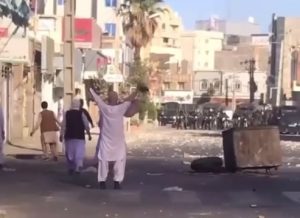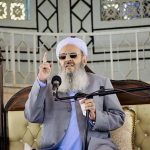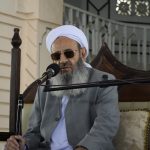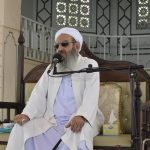September 30, 2022 was a bloody Friday in Zahedan that shocked all Iranians including Sunnis, and especially the people of Balochistan.
Following the death of a 22-year-old woman named Mahsa Amini after Tehran’s moral police arrested her, the sentiments of the Iranian people were hurt. When Amini was taken to the police custody on the charge of not wearing a full hijab, and then she died in the hospital, people began a nationwide anti-government demonstration in Iran. At the same time, some reports suggested that a police officer had sexually assaulted a young Baloch girl during interrogation in Chabahar city.
In this inflamed situation, on September 30 Zahedan’s Friday prayer was performed as usual in the former Grand Musalla in Razi Street, near the Makki Mosque. Just as the Friday prayers performed, some people gathered outside the Musalla to protest; in their slogans, demonstrators demanded the detention and punishment of the accused officer. The protestors moved towards the nearest police station located next to the Musalla. After a few minutes when they were near the station, the security and military forces opened fire at the protestors and worshipers inside and outside the place of worship and threw tear gas at them. Many military agents were already stationed on the roofs of people’s houses and targeted the worshipers with direct bullets.
Dozens of innocent worshipers, including several children and an old woman, were martyred and about three hundred people were injured on that bloody day. Some martyrs and wounded were taken to the main campus of Darululoom, and after several hours, they were transferred from there by ambulance to nearby hospitals. After the evening prayers, the military forces surrounded the Grand Makki Mosque and Darululoom Zahedan; they shot at the mosque and the building of Darululoom. Clashes spread the in whole city and tension between the people and the military forces began. Many young people were martyred and wounded around the Makki Mosque and all over the city. On the other side, a number of military forces were killed too. This sad day has been called and named the Bloody Friday.
After this tragic incident, the situation changed in the country and a big rift was created between the people and the state. Shaikh Abdol-Hamid began to criticize the officials more frankly and raised the demands of Iran’s Sunnis more clearly. This terrible incident showed that the situation in Balochistan has been so bad since the 1979 revolution. Iranians inside and outside the country understood that the people of Balochistan have been suffering from discrimination and injustice for decades.
This tragedy brought Iranian ethnic and religious communities closer together and united them. Baloch and Kurds were connected from the east and west of the country. After Mahsa Amini’s death, some women threw chadors and set their scarves on fire. But the Bloody Friday of Zahedan made many people to turn back to religion. The youth of the Kurdish regions who used to criticize Ulama, turned to the mosques and in some cities ninety percent of the youth started praying. The people of Balochistan became much more aware than the past and became closer to each other in religious matters.
Before the incident, Mawlana Abdol-Hamid’s speeches were not published in the media as widely as today. These days, satellite and social networks analyze Mawlana Abdol-Hamid’s speeches and thousands of people watch his Friday remarks live. Now, thousands of Iranians are waiting for the Friday day to listen to the speech of Shaikh Abdol-Hamid. The view of Iranians towards Sunnis has changed; Sunni scholars are highly respected among Shia citizens.
Following this unfortunate incident, thousands of people including scholars, intellectuals, heads of tribes and ordinary citizens from different regions of Iran, especially Sistan-Balochistan, come to Makki Mosque to express their solidarity with the people of Zahedan and Mawlana Abdol-Hamid.
The people have been demanding the arrest and execution of the perpetrators of massacres of the martyred worshipers. They say that the authorities must be accountable to the crime.
The people of Balochistan went on to begin a huge strike, while there were no such strikes in Baluchistan before. People are demonstrating and chanting slogans after every Friday prayer all over the province. Before that, street protests were not common in Iranian Balochistan, but Bloody Friday changed everything.
Unfortunately, at first, the provincial authorities sprinkled salt in people’s wounds by claiming a terrorist attack on the police station and called the worshipers rioters instead of expressing sympathy with them.
After Zahedan’s bloody Friday, another bloody Friday took place in Khash, where at least fifteen people were martyred when the security forces shot the worshipers. These demonstrations take place in a situation where there is no official invitation to protest from the Sunni clerics. Though people are arrested and some got injuries in these events, they still come to the streets.
Almost four months have passed since the shocking incident, but provincial and capital authorities have not been condemning the incident openly. Only the provincial governor and some officials have replaced. Some state-run media outlets insult Shaikh Abdol-Hamid and consider his criticisms against their aspirations.
After long time, it is still not clear why the worshipers were targeted by military forces so brutality. What was their fault? Are their killers foreigners? Why did they attack Sunni worshipers so brutally?
It is clear that this event happened according to a predetermined plan. It should be clarified what the hidden hands behind the crime wanted to achieve by planning such a massacre? In the coming days, many things will be known and there is a lot of hope that the blood of the martyrs will not lose.










Comments